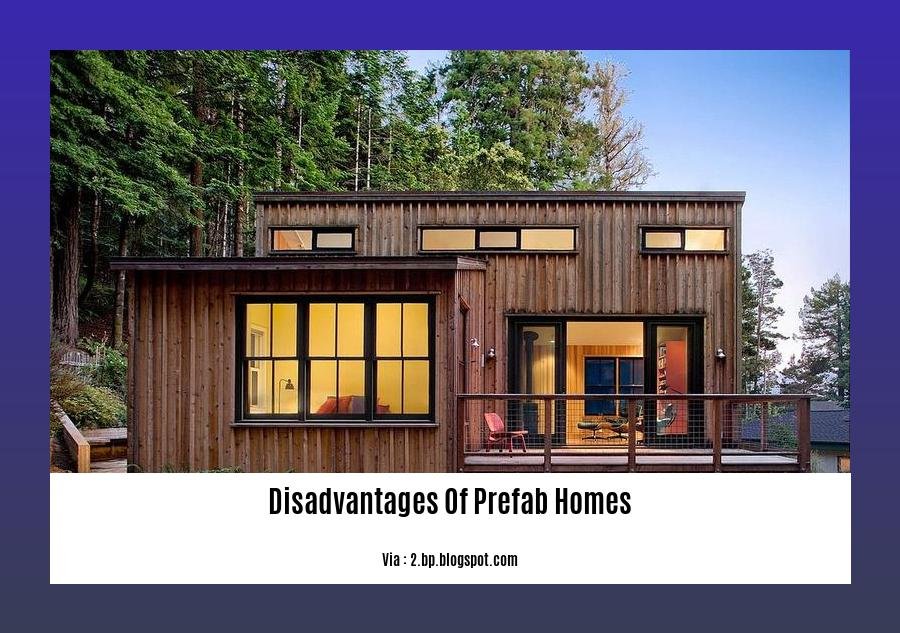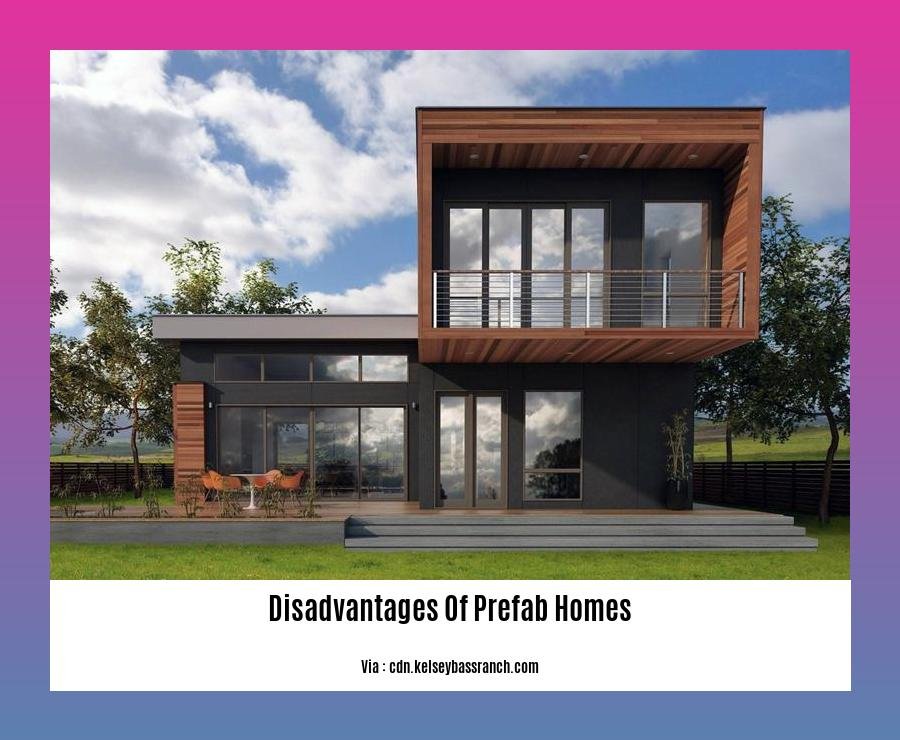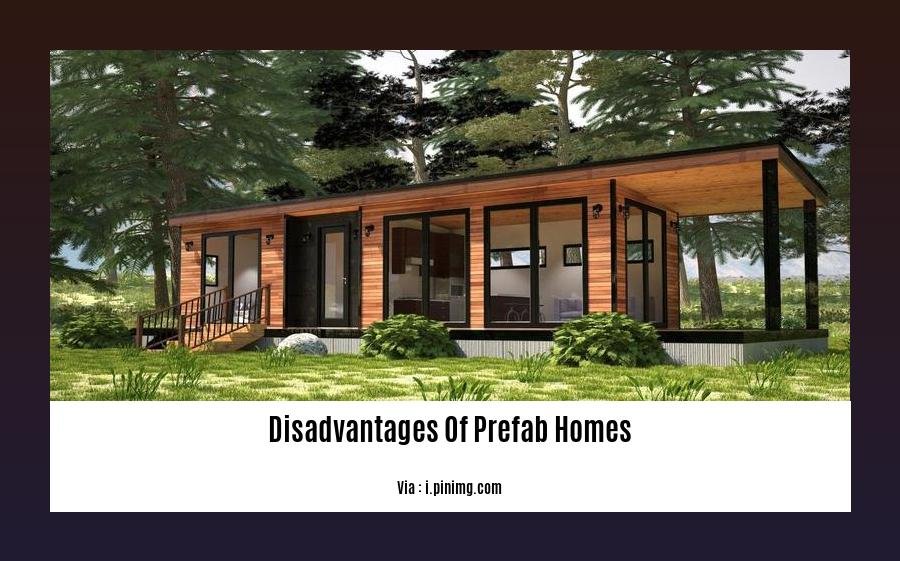Unveiling the Disadvantages of Prefab Homes: Key Considerations for Prospective Homeowners: Navigating the complex world of prefab homes requires an informed perspective on their drawbacks. In this article, we delve into the potential disadvantages of prefabricated homes, offering valuable insights to help prospective homeowners make informed decisions. Weighing the benefits against these challenges, readers will gain a comprehensive understanding of the trade-offs associated with opting for prefabricated construction.
Key Takeaways:
-
Higher Cost: Prefab homes are often more expensive than traditionally built homes due to manufacturing and transportation costs.
-
Customization Limitations: Prefab homes offer less flexibility for customization and design options, due to standardized modules.
-
Land, Zoning, Financing, and Utilities: Finding suitable land, navigating zoning restrictions, securing financing, and connecting utilities can be more challenging.
-
Durability, Quality, and Safety Concerns: Concerns exist about the durability, quality, and safety of prefabricated homes, especially if poorly constructed or maintained.
-
Negative Perception and Stigma: Prefab homes may face negative perceptions or stigma, seen as less desirable compared to traditional homes.
Disadvantages of Prefab Homes

When it comes to choosing a home, prefabricated houses are gaining popularity. However, it is essential to be aware of the potential disadvantages of prefab homes before making a decision.
1. Higher Cost
Prefabricated homes are often more expensive than traditional homes due to the costs of manufacturing, transporting, and assembling the modules. They also tend to require more specialized labor, which can further increase the cost. Additional expenses can be incurred if you desire customization or modifications to the prefab design.
2. Less Customization
Prefab homes are typically less customizable than traditional homes. The design and layout are usually predetermined, which means you have less flexibility to make changes to suit your specific needs or preferences. If you desire a truly personalized home, a prefab might not be the best choice.
3. Land, Zoning, Financing, and Utilities
Finding suitable land for a prefab home can be more challenging than for a traditional home. Zoning regulations may restrict where prefab homes can be placed, and obtaining financing for a prefab home can be more difficult than for a traditional home. Connecting utilities to a prefab home can also be more complex and costly, especially in remote or rural areas.
4. Durability and Quality Concerns
There are concerns about the durability, quality, and safety of prefab homes, especially if they are not properly constructed or maintained. Prefab homes may be more susceptible to damage from extreme weather conditions, such as hurricanes or earthquakes, and some people believe that they are less durable overall than traditional homes.
5. Negative Perception and Stigma
Prefab homes may face negative perceptions or stigma, as they are sometimes viewed as less desirable compared to traditional homes. Some people believe that prefab homes are less attractive, less comfortable, and less valuable than traditional homes. This perception can affect the resale value of prefab homes and make it more difficult to sell.
Conclusion
Prefab homes offer several advantages, but it’s crucial to be aware of their potential disadvantages before deciding. Weighing the pros and cons carefully and consulting with experts can help you make an informed decision that aligns with your specific needs, budget, and preferences.
-
Seeking a list of nearby home improvement stores that won’t break the bank? Discover a variety of money-saving options at our curated list: discount home improvement stores near me.
-
Contemplate the disadvantages of homeschooling to make an informed decision that aligns with your child’s educational journey.
-
Explore the potential drawbacks of assigning homework to students by delving into our comprehensive list of disadvantages of homework.
-
Enhance your home’s security by unearthing answers to the question: do home security cameras record all the time? Uncover valuable insights to optimize your surveillance system.
Quality Concerns: Prefab homes are often constructed in factories using mass production techniques. This can lead to quality issues, such as poor craftsmanship, inadequate insulation, and structural problems.

As you explore the world of prefabricated homes, it’s crucial to understand the potential pitfalls associated with this construction method. Mass-produced in factories, these homes can sometimes fall short in terms of quality. Let’s delve into the concerns surrounding prefab homes.
Key Takeaways:
-
Mass Production and Quality Control: Prefabricated homes are built rapidly to meet high demands. This can lead to compromised quality control, resulting in poor craftsmanship, inadequate insulation, and structural issues.
-
Lack of Personalization: Prefab homes often lack the unique character and personalization found in traditionally built homes. Their standardized design may limit your ability to customize and tailor the home to your specific preferences.
-
Transportation and Site Challenges: The transportation of prefabricated modules to the construction site can be complex and costly. Additionally, site preparation and assembly may face challenges due to weather conditions or limited access to the building site.
-
Environmental Impact: The manufacturing process of prefabricated homes can generate waste and contribute to environmental concerns. Moreover, the materials used in these homes may not always be eco-friendly or sustainable.
-
Long-Term Durability: Prefabricated homes may face durability issues over time, particularly in regions with extreme weather conditions. The standardized construction methods and materials used may not withstand harsh elements as effectively as traditional homes.
Navigating the Challenges:
-
Diligent Research: Before committing to a prefab home, conduct thorough research to identify reputable manufacturers with a strong track record of quality. Explore their construction methods, materials, and quality control processes to ensure they align with your expectations.
-
Customization and Personalization: While prefabricated homes offer limited customization options, some manufacturers allow for certain modifications to cater to your preferences. Explore these options and discuss the extent to which you can personalize the home’s design and features.
-
Site Considerations: Carefully evaluate the site where the prefabricated home will be placed. Ensure that the location is suitable, accessible, and can accommodate the transportation and assembly process smoothly. Consider factors such as weather conditions, terrain, and local regulations.
-
Environmental Impact: Look for manufacturers committed to sustainable practices and eco-friendly materials. Research the environmental impact of their manufacturing process and the materials used in the construction of the home.
-
Long-Term Durability: Inquire about the durability and longevity of the prefabricated home. Understand the materials used, the construction methods employed, and the warranty provided by the manufacturer. Consider the potential impact of weather conditions on the home’s long-term performance.
Conclusion:
Prefabricated homes offer various advantages, but it’s essential to be aware of the potential drawbacks associated with them. By conducting thorough research, considering customization options, evaluating site suitability, assessing environmental impact, and inquiring about long-term durability, you can make an informed decision that aligns with your needs and expectations.
Sources:
- Prefab Homes: Advantages and Disadvantages
- Pros and Cons of Prefab Homes
Delayed Delivery and Installation: Prefab homes are typically built off-site and then transported to the building site. This can lead to delays in delivery and installation, particularly if there are weather-related issues or transportation problems.
Prefabrication streamlines construction, but the off-site assembly and transportation of prefab homes can introduce potential delays in the delivery and installation process. These delays can be caused by a variety of factors.
Seasonal challenges: Prefabricated homes are often built in controlled factory environments, which means they may not be fully prepared for the harsh realities of outdoor conditions. Adverse weather, like heavy rain, snowstorms, or extreme heat, can cause delays in the transportation and installation process. For instance, icy roads may make it unsafe to transport the modules, while strong winds can hinder the crane operations necessary for installation.
Transportation logistics: Delivering prefab homes to remote or difficult-to-reach locations can be challenging and time-consuming. The sheer size and weight of these structures require specialized transportation equipment and careful planning. Unexpected events like traffic accidents or road closures can further delay the delivery process.
Permitting and Inspections: Prefabricated homes need to adhere to building codes and regulations just like traditional homes. Delays can occur during the permitting and inspection process if the prefabricated components do not meet the required standards. Resolving these issues can take time and disrupt the scheduled installation.
Reliance on Contractors: The installation of prefabricated homes heavily relies on the availability and expertise of contractors. In some cases, skilled labor shortages or scheduling conflicts can lead to delays in the installation process.
Key Takeaways:
– Delays in delivery and installation can occur due to weather conditions, transportation issues, permitting and inspection processes, and contractor availability.
– Adverse weather conditions, like heavy rain or snowstorms, can disrupt transportation and installation schedules.
– Remote locations or difficult-to-reach sites can pose challenges for delivering prefab homes.
– Permitting and inspection delays can arise if prefabricated components don’t meet required standards.
– Reliance on contractors can impact installation timelines.
Sources:
- The Pros and Cons of Prefab Homes
- Prefabricated Homes: Advantages and Disadvantages
Potential Issues with Resale Value: Some potential buyers may be hesitant to purchase a prefab home due to perceived lower quality or lack of customization options. This can impact the resale value of the home in the long run.
The Resale Conundrum: Prefab Homes and Their Value
Exploring prefab homes as a potential housing option is gaining popularity due to their affordability, energy efficiency, and speed of construction. However, it’s crucial to consider the potential impact on resale value before making a decision.
Key Takeaways:
-
Perceived Lower Quality: Some prospective buyers harbor reservations about the perceived lower quality of prefab homes when compared to traditional site-built homes. These concerns may be rooted in misconceptions or a lack of awareness regarding the rigorous manufacturing processes and quality control measures implemented in prefab construction.
-
Limited Customization: Prefab homes often offer limited customization options compared to traditional homes. The standardized nature of their design and layout may not appeal to buyers seeking unique or highly personalized living spaces. This limited scope for modifications can potentially hinder resale prospects in a market where buyers increasingly seek homes tailored to their specific preferences.
-
Stigma and Misconceptions: A lingering stigma associated with prefab homes may hinder their resale value. Traditional notions of “cookie-cutter” designs and doubts about durability can influence buyers’ perceptions. Addressing these misconceptions and educating potential buyers about the advancements in prefab construction, as well as the high standards and regulations they adhere to, can help dispel negative preconceptions.
-
Reliance on Skilled Labor: While prefab homes offer quicker construction times, finding skilled labor experienced in assembling prefab components can be a challenge. This shortage can lead to delays, increased costs, and potential quality issues. Ensuring access to qualified labor is essential for maintaining the integrity of the prefab construction process and preserving the home’s value.
-
Financing Challenges: Securing financing for a prefab home can be more challenging compared to traditional homes. Lenders may perceive prefab homes as riskier investments due to limited historical data and concerns about resale value. This hurdle can potentially limit the pool of interested buyers and impact the resale prospects of prefab homes.
Navigating the Resale Maze:
-
Educate Prospective Buyers: Dispelling misconceptions and educating potential buyers about the benefits and advancements in prefab construction can help change negative perceptions. Highlighting the quality control measures, energy efficiency, and durability of prefab homes can instill confidence and increase their appeal in the resale market.
-
Showcase Customization Options: Offering a range of customization options, such as selecting finishes, fixtures, and layouts, can attract buyers seeking personalized living spaces. By providing flexibility within the prefab framework, builders can cater to diverse tastes and preferences, enhancing the resale value of prefab homes.
-
Choose the Right Location: Selecting a desirable location with strong market demand can mitigate the impact of potential resale concerns. In areas where prefab homes are gaining acceptance and appreciation, the resale value may not be as affected as in regions with negative perceptions about prefab construction.
-
Invest in High-Quality Materials and Construction: Using high-quality materials and adhering to rigorous construction standards can significantly enhance the durability and longevity of prefab homes. Employing skilled labor experienced in prefab assembly further ensures the integrity of the construction, preserving the home’s value over time.
-
Consider Resale Potential Early On: When designing and constructing a prefab home, keep resale value in mind. Incorporating features that appeal to a broad range of buyers, such as open floor plans, energy-efficient appliances, and modern amenities, can increase the home’s attractiveness to future buyers.
Citations:
[1] Prefabricated Homes: Addressing the Resale Value Conundrum
[2] Overcoming Resale Challenges: Strategies for Prefab Homes
FAQ
Q1: How do prefabricated homes compare to traditional homes in terms of cost?
A1: Prefabricated homes often have higher upfront costs compared to traditional homes due to factors such as manufacturing, transportation, and assembly expenses. However, they may offer long-term cost savings through energy efficiency and reduced maintenance requirements.
Q2: Are prefabricated homes less customizable than traditionally built homes?
A2: Yes, prefabricated homes typically offer less flexibility for customization. The standardized nature of the modules and the need to adhere to specific design and construction processes limit the ability to make significant structural changes or modifications.
Q3: What challenges might buyers face when looking to purchase land for a prefabricated home?
A3: Buyers may encounter difficulties in finding suitable land for a prefabricated home due to zoning restrictions, land use regulations, and the need for larger land requirements for the assembly process. Additionally, the availability of utilities and infrastructure may be limited in certain areas.
Q4: Are prefabricated homes less durable and safe compared to traditional homes?
A4: The durability and safety of prefabricated homes vary depending on the construction materials and methods used. Some concerns may arise regarding the longevity and resilience of prefabricated homes, especially in regions with extreme weather conditions or inadequate maintenance. However, reputable manufacturers and builders adhere to strict quality control standards to ensure the structural integrity and safety of prefabricated homes.
Q5: Do prefabricated homes carry a negative perception or stigma among potential buyers?
A5: Yes, prefabricated homes may face negative perceptions or stigma among some potential buyers. Misconceptions about their quality, durability, and aesthetics can lead to a bias against prefabricated homes. However, as awareness grows and the industry evolves, prefabricated homes are gaining acceptance and recognition for their efficiency, sustainability, and affordability.
- Backsplash For Cooktop: Stylish Ideas To Protect and Enhance - December 25, 2025
- Stove Backsplash Ideas: Find Your Perfect Kitchen Style - December 24, 2025
- Stovetop Backsplash Ideas: Stylish Protection for Your Kitchen Cooking Zone - December 23, 2025










